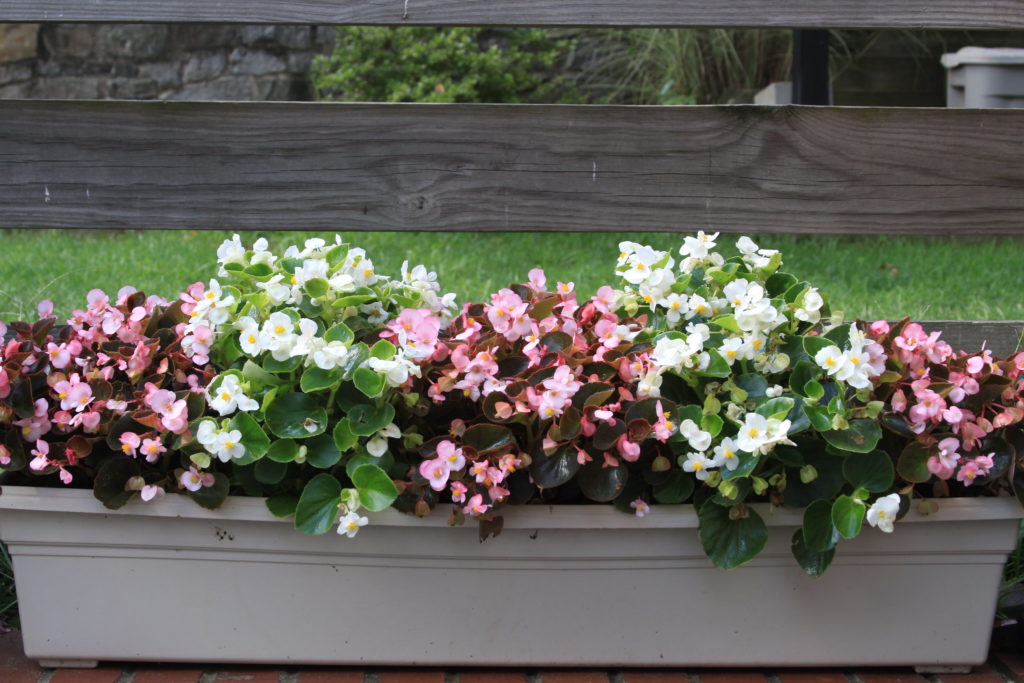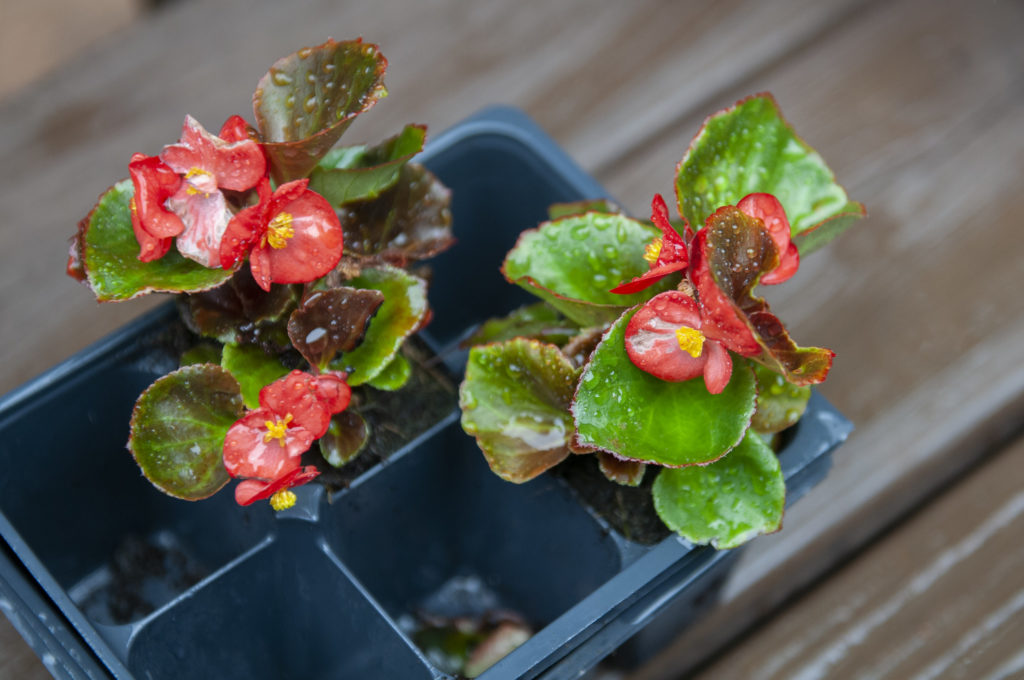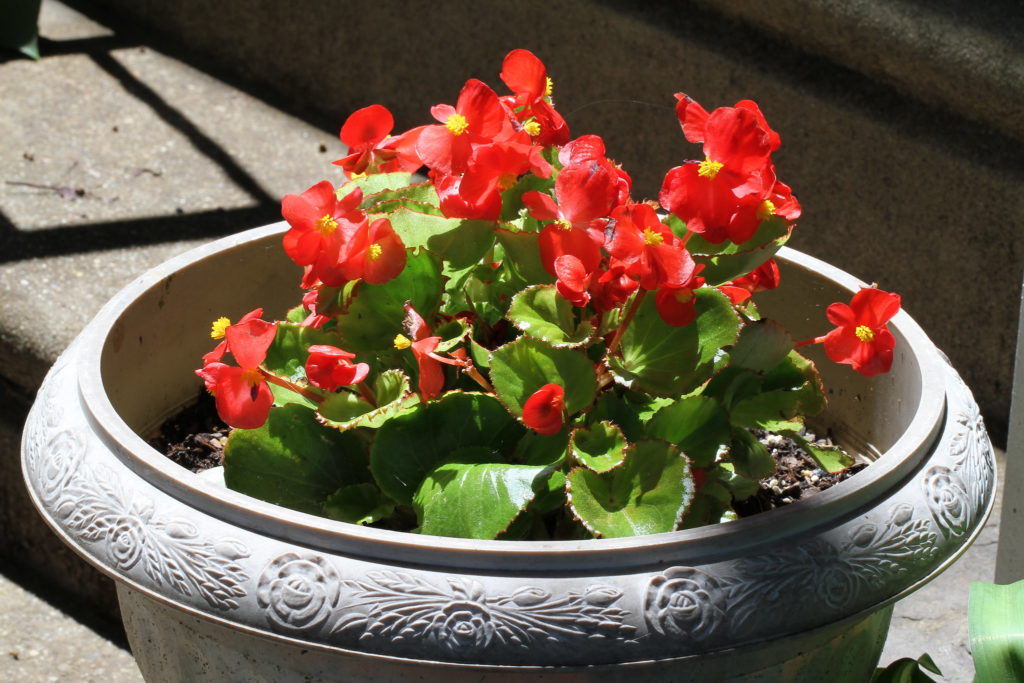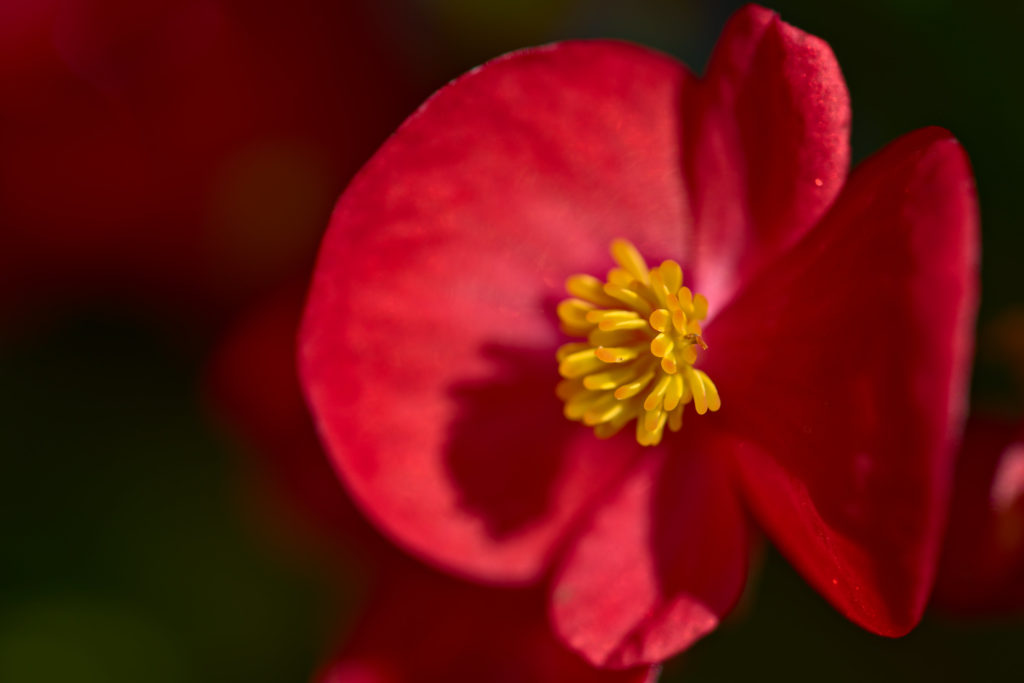The huge variety of begonia cultivars includes literally thousands of heirloom and hybrid species. Different types are native to Central and South America, Asia, and Africa. They were grown in China in the 1300s, and in the West, they were documented as being cultivated starting in Brazil in the 1600s. In Europe, they were imported both from Brazil and India in the 1800s. They are subtropical perennials in origin but are often grown as annuals in more temperate regions.
How to Grow Begonias
Begonias are a plant that prefers shade, or partial shade. They are great as potted plants or for use in the garden. There are several main types, all with different “looks.” There are two main types that are most familiar. The first is Tuberous Begonias, which are started from tubers in late spring in the garden. The second is Semperflorens Begonias, often called Wax Begonias, started from seed in containers. These can be transplanted into long-term pots or into the garden. There are several other types, including shrub-like, thick-stemmed, and cane-like begonias. Popular container plants include trailing-scandent and Rhizomatous begonias, and the beautifully leaved Rex Cultorum.

- Begonia
- Perennial (grown as annual in colder climates)
- Partial shade
- Well-drained sandy and loamy slightly acidic soil (5.5 to 6.5 pH).
- Start seedlings or cuttings indoors in the late fall.
- Plant in the garden 2 weeks after the last frost in spring.
- Plant 48″ apart for healthy shrubs.
- Growing in containers:
Start single plants in at least 12″ deep, and 16″ wide pots
The pot should be about as wide as the foliage, move to a larger pot as it grows
Ensure good drainage and acidic soil
- Water regularly, keeping the soil moist.
- Most species can be grown as a perennial in Climate Zones 8-11
Grown as annuals in temperate areas, or in containers and brought inside in winter.
- The Hardy Begonia (Begonia Grandis) is hardy in Climate Zones 6-9
Tuberous Begonias can be sprouted early before planting in the garden. The tubers themselves are slightly bowl-shaped. It is very important that they are planted with the dish facing up. Most of the flowering sprouts will grow from the dish but roots can grow out all over. In early spring, keep them in a warmer area out of direct light, without planting them. They will sprout small buds that will grow slightly. Once they have a few leaves, and the temperature outside is at least 50° F at night, plant them in the garden. These should be planted in partial shade, either dappled shade under a tree, or a place with morning sun and afternoon shade. Too much sun will damage the plant, causing leaves to wilt and damaging the blooms. Tubers should be planted about 6 inches apart, in well-drained, slightly acidic soil. Sandy and/or loamy soil is best, but they will grow in clay soil just fine. At the risk of being repetitious, ensure that the soil is well-drained! Overly wet soil can lead to root and stem rot for this plant. One variety of tuberous begonias, the Hardy Begonia, can be grown as a perennial in zones 6-9, which makes it pretty popular in the southeast and mid-west regions of the US.

Wax Begonias can be started from seeds or cuttings. About three months before the last frost of spring, start seeds indoors, shallowly planted into the soil. Unlike the tubers, these seeds need sunlight or growing lights to get started. Once planted, the soil should be kept moist, and the air humid by using either a “humidity dome” or just a large clear plastic bag. Warmer temperatures can help them germinate a bit faster, but they do take some time to get going. Once you get some sprouts with a few leaves, transplant them into a small container. Keep warm and lighted, and after the last frost, plant them about 6 inches to 8 inches apart in the garden bed. The soil should be well-drained, and slightly acidic. Wax begonias can do full sun in colder climates, but in areas that get hot summers, plant in partial shade. In warmer climates or for potted plants, wax begonias can also be started from cuttings in the spring, by cutting a stem that is about 3-4 inches long, with a few leaf nodes. Bury the cut end in the soil and it will start a new plant.
Shrub-like begonias can be quite large, and cane-like begonias will look like bamboo stems and can be very tall. The cane-like plants are easiest to start from cuttings and starting that way, they should be the same as the parent plant. They can be started from seed, though they can be hybrids, and may grow flowers that are different from the parent plant. Planting and caring for these plants is similar to the care for other types of begonias.
Growing Begonias in Containers
For potted plants, use small containers at first. Gradually plant and re-plant into successively larger containers. 6-8 inch wide pots are usually the largest size. Small plants in larger containers can increase the likelihood of root rot. A long and large pot can be used for multiple plants, but plants keep them 6 inches apart. All containers should be well-drained, and seedlings or tubers should be planted firmly, but not tightly into the pot. Loose soil can lead to uneven water distribution and tightly packed soil can sometimes damage the roots. Potted begonias should be watered often but still, ensure that the pot is well drained. Container plants should be fertilized regularly, throughout their lifespan. The best is a slow-release balanced 20-20-20 mix fertilizer (with nitrogen, potassium, and phosphorous), to help avoid fertilizer burn. Back off on fertilizer for about a month if the leaves become spotted.

Begonias are warm-weather plants. They don’t do well in freezing temperatures except for the hardy begonia. In the garden, they are grown as annuals in colder climates. Tuberous begonias can be kept alive in zones 4-7, by digging up the tubers to be re-sprouted and planted the following year. Begonias can be grown as perennials, in warmer climates like Southern California, or Florida, though most will go dormant and re-sprout in the spring. Rhizomatous begonias do not go dormant, though they need a warm climate.
Begonia Companion Plants
Hostas and ferns do very well with begonias since they have similar soil and light needs. They can also offer a great complimentary color contrast to the begonia plants. Other good plants that do very well near begonias include Saint John’s Wort, Impatiens, and Creeping Jenny.
Begonia Pests and Diseases
Pests that bother begonias both in the garden and in containers include aphids, white flies, nematodes, thrips, mealy bugs, and especially mites. Snails and slugs can be a problem for garden begonias, and a good natural solution for these is to sprinkle diatomaceous earth around the base of the begonia, in a circle a few inches away from the plant. Make the line 1-2 inches wide, and they won’t cross this line. Soapy water sprayed onto the plant will kill aphids. Mealybugs can be stopped by spraying lightly with rubbing alcohol. Diluted neem oil sprayed onto the plant is also an effective, organic remedy that prevents pests, or drives them away.
Plant diseases can include fungi like powdery mildew and root rot, as well as bacterial problems like leaf spot. For fungal diseases, a natural solution is to spray the plant with water and baking soda. Mix one tablespoon of baking soda with a quart of water and spray the plant thoroughly. As a note, soapy water, alcohol, baking soda, diatomaceous earth, and neem oil are natural remedies, that will not damage your plants, For leaf spot, remove any infected leaves, and dispose of them in the trash (not in your compost). Effective anti-fungal, anti-bacterial, and pesticide sprays are also available if you prefer.

For replanting wax begonias the next year, harvest seed pods in the fall, from behind the female flowers. Once they start to dry out, cut them off and put them in a paper bag or other container. Empty the seedpods onto a smooth piece of paper and empty the pods. Separate the seeds into a plastic container. Let the seeds dry for a week or two, then separate the dried seeds from any remaining plant debris and save them for sprouting and planting the following spring.
Begonias are beautiful and easy-to-grow flowers. They work great to put color in the shady spots of your garden, or as a beautiful potted plant. There is some care needed, and it’s important to pick the variety that is best for your garden or patio, but they are versatile, and will work in a lot of different places and settings!

Contact Author
 info@gardensavvy.com
info@gardensavvy.com Recent Posts
- Smart Gardening: How Technology Is Revolutionizing Horticulture
- Understanding Gardening Zones: What You Need to Know
- The Right Tools For Your Gardening And Landscaping Needs
- Maximizing Your Harvest: Square Foot Gardening Chart for Beginners
- Holiday Garden Scents: Plants for Natural Aromatherapy in Your Home









